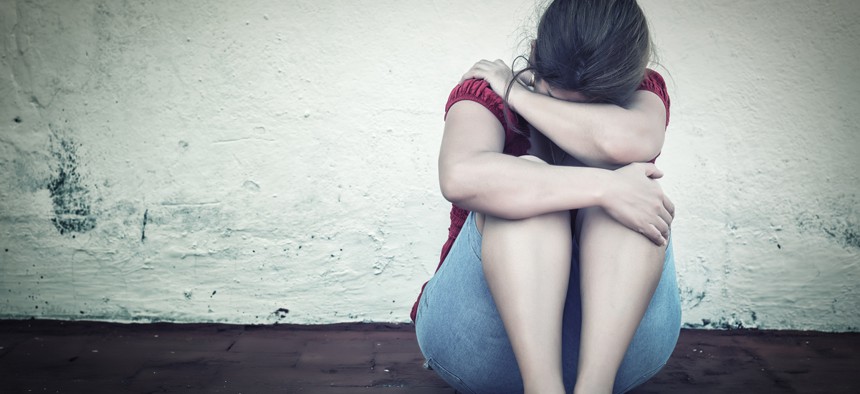Stay-At-Home Orders Can Be Dangerous for Victims of Domestic Violence. But Help Is Still Available.

Law enforcement agencies across the country have reported increases in domestic violence calls since stay-at-home orders went into effect. Shutterstock
Roughly half of agencies providing help to victims of domestic violence are closed during the coronavirus outbreak, but many have transitioned to virtual or phone services.
Stay-at-home orders are in place in at least 42 states, movement restrictions designed to keep people safe during the coronavirus pandemic. But those recommendations can heighten risk for victims of domestic violence, who are now alone at home with their abusers with little privacy or opportunity to seek help.
“When we look at risk factors for domestic abuse, elder abuse and sexual violence, isolation is a top risk,” said Catherine Johnson, director of the Guilford County Family Justice Center in Greensboro, North Carolina. “Right now families are more isolated, and that’s a risk for conflict to increase in families that already have conflict. We believe there are a lot of people who either don’t feel like they can leave because they don’t have an excuse to get out of the house to seek services, or because they think that services are closed.”
Across the country, some victims’ services hotlines and websites are seeing spikes in traffic, while law enforcement officials are reporting increased numbers of domestic violence calls. From February to March, domestic violence calls spiked 30% in Salt Lake City, 20% in Houston, 18% in Charlotte, North Carolina, and 6% in Phoenix, according to an analysis by NBC News. In Virginia, calls to domestic violence hotlines increased by 76% statewide last month, according to a state organization.
The National Domestic Violence Hotline reported that many survivors are calling to discuss concerns about “how their abusive partner is leveraging Covid-19 to further isolate,” said Katie Ray-Jones, CEO of the hotline and its sister nonprofit loveisrespect.
The national hotline’s overall call volume had not increased, Ray-Jones said, remaining between 1,800 and 2,000 calls per day. But she said that’s not surprising given the basic premise of stay-at-home orders—that everyone, abusers and victims included, are at home.
“While we don't necessarily expect to see healthy relationships becoming abusive, our experience informs us that in homes where abuse is already occurring, and there is a negative financial impact or added stress in the home, we typically see a higher frequency of incidents of abuse and increased severity of abuse,” she said. “We are especially concerned that survivors will be unable to reach out for help due to their abusive partner monitoring the behaviors while they are in isolation.”
Requests for help have also not increased at the Guilford County Family Justice Center, a city-county partnership that houses a multitude of agencies and care providers, with the goal of making the justice system easier for victims to navigate.
“The percentage of people coming in is lower, but of those people coming in, a higher percentage of people have intense things going on,” Johnson said.
The center remains open during the outbreak, Johnson said, as domestic violence services were deemed essential by county leadership.
“I gave my staff the option to stay home if they felt uncomfortable, but most did not feel that way and are still coming in,” she said. “We are working one day from home, but we’re still here.”
Her facility is in the minority. Roughly half of similar agencies across the country are closed, though they have largely shifted to remote and online services, according to estimates from the Alliance for HOPE International.
In New York City, for example, Family Justice Centers in all five boroughs closed their doors and moved to phone services in March. Attorneys general from each borough reminded victims that services were still available, including help locating emergency shelter or filing a restraining order.
“These are challenging times for everyone, especially those who must stay home with an abusive partner,” said Brooklyn District Attorney Eric Gonzalez. “But even during this health crisis, you don’t have to suffer in silence. My office and our partners still offer a wide array of supportive services for those experiencing violence in their home.”
A handful of state leaders also acknowledged the crisis, stating explicitly in stay-at-home orders that victims of domestic violence were still free to leave their homes if their living situations became unsafe. Washington Gov. Jay Inslee, for example, stated in his proclamation that victims of domestic violence “are permitted and urged to leave their homes or residences and stay at a safe alternate location.”
Still, many agencies are bracing for an increase in requests for service after stay-at-home orders are lifted and people begin re-engaging with society. That may be the first chance that most victims have to tell someone what they’ve gone through, Ray-Jones said.
“We suspect that we may not see a surge in individuals reaching out until shelter-in-place protocols are lifted,” she said. “As people start returning to work or school and are apart from their abusive partners, it will be safe and private to reach out for support.”
In the meantime, Johnson said, it’s important for victims to recognize that help is still available.
“Help is still here and so is hope,” she said. “All of the same resources still exist. The details are just different in some places.”
OTHER STORIES on Route Fifty:
Kate Elizabeth Queram is a Staff Correspondent for Route Fifty and is based in Washington, D.C.
NEXT STORY: Housing Advocates Push for a Rent Freeze During Covid-19 Pandemic





